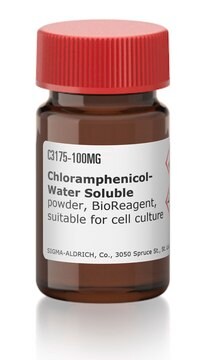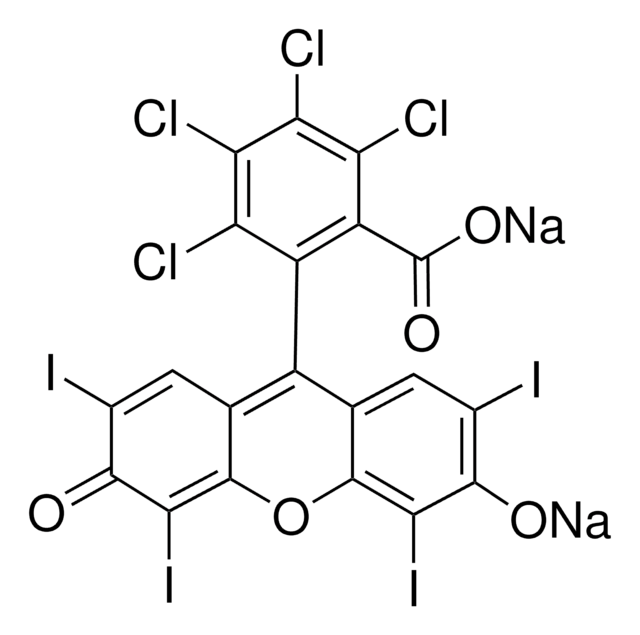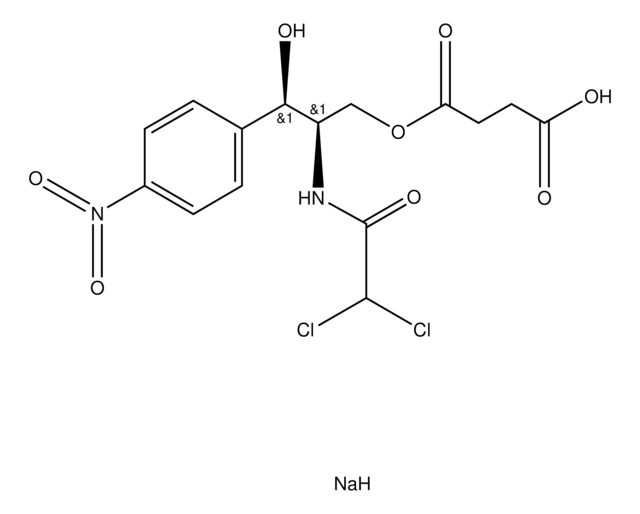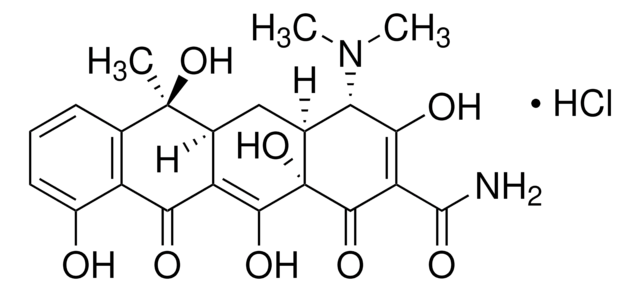C1919
Cloranfenicol
BioReagent, suitable for plant cell culture
Sinônimo(s):
D-()-treo-2,2-dicloro-N-[β-hidroxi-α-(hidroximetil)-α-(hidroximetil)-4-nitrofenetil]acetamida, D-(−)-treo-2,2-dicloro-N-[β-hidroxi-α-(hidroximetil)-β-(4-nitrofenil)etil]acetamida, D-(−)-treo-2-dicloroacetamido-1-(4-nitrofenil)-1,3-propanodiol, Cloromicetina
About This Item
Produtos recomendados
linha de produto
BioReagent
Nível de qualidade
forma
powder
técnica(s)
cell culture | plant: suitable
Impurezas
Endotoxin, tested
pf
149-153 °C (lit.)
espectro de atividade do antibiótico
Gram-negative bacteria
Gram-positive bacteria
mycobacteria
mycoplasma
aplicação(ões)
agriculture
Modo de ação
protein synthesis | interferes
temperatura de armazenamento
2-8°C
cadeia de caracteres SMILES
OC[C@@H](NC(=O)C(Cl)Cl)[C@H](O)c1ccc(cc1)[N+]([O-])=O
InChI
1S/C11H12Cl2N2O5/c12-10(13)11(18)14-8(5-16)9(17)6-1-3-7(4-2-6)15(19)20/h1-4,8-10,16-17H,5H2,(H,14,18)/t8-,9-/m1/s1
chave InChI
WIIZWVCIJKGZOK-RKDXNWHRSA-N
Informações sobre genes
human ... CYP1A2(1544)
Procurando produtos similares? Visita Guia de comparação de produtos
Categorias relacionadas
Descrição geral
Aplicação
Ações bioquímicas/fisiológicas
Modo de resistência: O uso da cloranfenicol acetiltransferase acetila e inativa o produto.
Espectro da ação antimicrobiana: Este é um antibiótico de amplo espectro contra bactérias gram positivas e gram negativas e é usado principalmente para fins oftálmicos e veterinários.
Atenção
Nota de preparo
Outras notas
Palavra indicadora
Danger
Frases de perigo
Declarações de precaução
Classificações de perigo
Carc. 2 - Eye Dam. 1 - Repr. 2
Código de classe de armazenamento
11 - Combustible Solids
Classe de risco de água (WGK)
WGK 3
Equipamento de proteção individual
Eyeshields, Gloves, type P3 (EN 143) respirator cartridges
Certificados de análise (COA)
Busque Certificados de análise (COA) digitando o Número do Lote do produto. Os números de lote e remessa podem ser encontrados no rótulo de um produto após a palavra “Lot” ou “Batch”.
Já possui este produto?
Encontre a documentação dos produtos que você adquiriu recentemente na biblioteca de documentos.
Os clientes também visualizaram
Artigos
Antibiotic kill curve is a dose response experiment in which mammalian cells are subjected to increasing amounts of selection antibiotic
Nossa equipe de cientistas tem experiência em todas as áreas de pesquisa, incluindo Life Sciences, ciência de materiais, síntese química, cromatografia, química analítica e muitas outras.
Entre em contato com a assistência técnica










